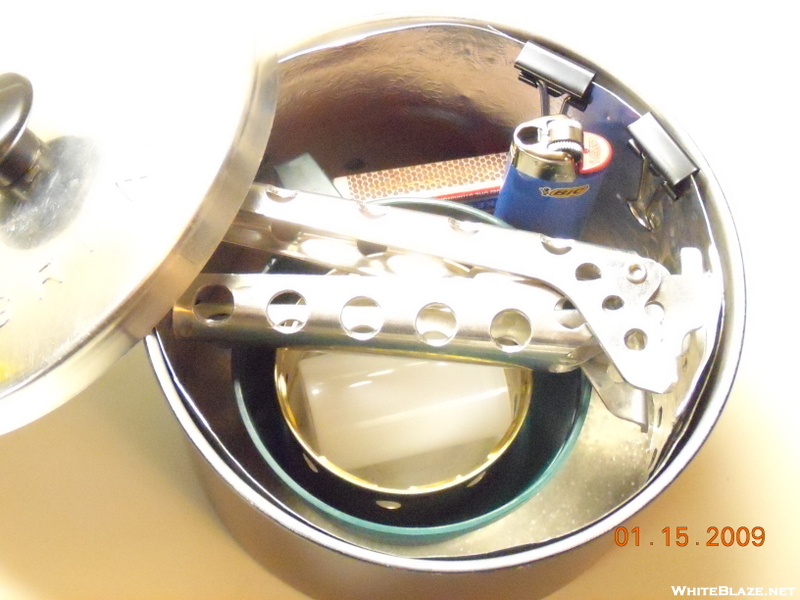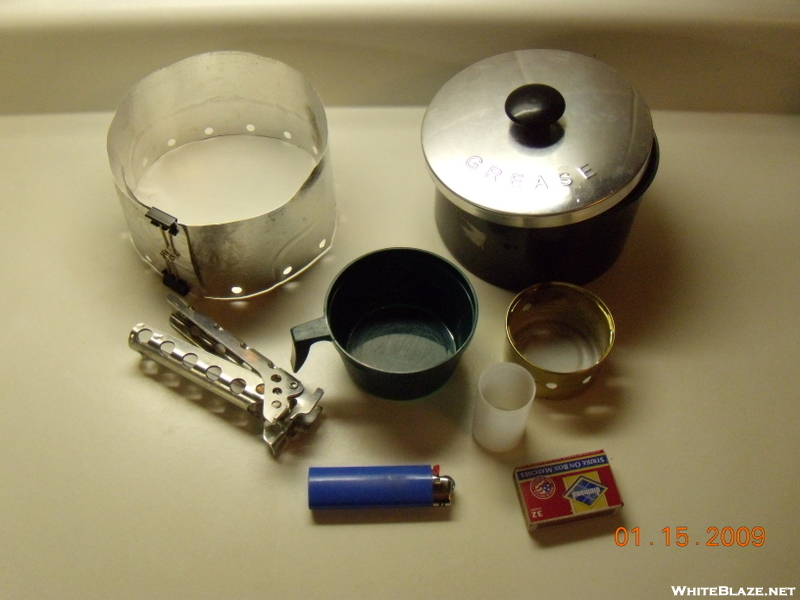I have heard some on this forum and others say that an alcohol stove is not good for cold weather. So I decided to try it out.
I checked the temperature on weather.com. Here in Glidden, IA,(1/15/09) it was -9 F (real temperature! windchill in the -20's) with a 5-10mph wind. Very cold! Perfect for finding out what my supercat can really do!
Jim Falk's version of the supercat only has 8 holes around the middle of the can, so it burns slower than your typical supercat. This turned out to be a problem.
My first test wasn't much of a test. I took water from the cold tap (probably 65F) and my room temperature Heet and the rest of my cooking gear outside. I used about an ounce of heet (one full film container's worth. I know, it's alot, but I didn't know how much the stove would use in these extra cold temps), and lit the stove with my bic lighter. I let the stove prime for 30 seconds, placed two cups of water on top, and had boiling water in maybe 6 minutes. Not bad! But not a realistic test, either!
By the way, did you know that when you throw a pan of boiling water into the air in -9F, it freezes before it hits the ground!?!
My next test revealed alot about my cooking setup! (Failure does that quite well) I let my gear sit outside for 15 minutes as well as the water and Heet before trying it again. The water quickly formed a layer of ice over it, which I broke and poured two more cups of the now 32F water into my freezing cold pot. I measured out another ounce of now freezing cold heat and try to start the stove with my freezing cold bic lighter.
My fingers and toes were beginning to numb at this point. I couldn't work the lighter with my gloves on, so I took them off to flick the bic a half-dozen times. Nothing. Must have frozen up! So I try the box of matches that I also keep in my cooking gear. It took me three matches to get the alcohol to vaporize and light. But I finally got it! (good thing, too, I can no longer feel my finger tips!) I let the stove prime for longer than the first time until it is burning good, put the windscreen on, put the pot on, and then run back inside. I desperately try to warm my fingers by wrapping them around an incandescent light bulb. Then I watched. After a couple minutes, I get curious and venture back out to see if the water is boiling. It's not. The stove went out. Sigh...most of my fuel is left, so I give it another go. Same thing happens.
The third time, I pull my windscreen apart to see exactly what is going on. When the flames start to go out, I pulled the pot off of the stove and it jumps back to life. I did that twice, and then my fuel went out.
I learned a couple of things about stoves in cold weather. The first is that you absolutely have to have a reliable fire source that is easy to ignite with cold fingers! And preferably, more than one! Bic lighters don't work in -9F unless you keep them warm in your pocket. They are also very difficult for me to use when my fingers don't want to cooperate. Regular matches were much easier to use, but even they were difficult to light in just a slight wind.
Second thing I learned is that you should keep all of your kitchen gear in one place and be completely comfortable using it before you attempt to use it in that cold of weather. I need more practice so that I can get things going quickly and efficiently.
Thirdly, my stove is not designed for that cold of weather. My supercat has only eight holes punched in it. It works great in the other three seasons! Last summer, I was able to boil four cups of water with one ounce of fuel! But it couldn't burn hot enough to keep the Heet boiling like it is supposed to in -9F weather. The cold pot absorbed the heat too quickly for the stove to keep itself primed. But I think that regular supercat with two rows of holes would burn hot enough to keep the stove primed and would boil the water. I will have to try it again another time. A simple, open-flame stove would burn just fine, I bet, but I am really curious to know how a pressurized stove like the Bios 2 or Zelph's Cobalt stove would work...
Anyway, please share your experiences with alcohol stoves at extreme temps. Any tips for me? I know someone mentioned that pretty much everyone in the Iditarod(sp?) dog-sled races uses alcohol stoves, does anyone know what kind of alcohol stove they use?
Also, can anyone recommend a good titanium pot that is roughly the same size and capacity as my Kmart grease pot? It is the perfect size and holds all my kitchen gear.

- Home
- Forum
- Journals
- Gallery
- What's New?
- Todays Posts
- 2,000 Miler Listing
-
Odd & Ends
- About WhiteBlaze/Tools
- About WhiteBlaze
- WhiteBlaze user agreement
- WhiteBlaze logo progression
- WhiteBlaze screen savers
- Purchase a banner spot
- Quick reference
- Usercp
- Subscribed Threads
- Members List
- Calendar
- Mark all forums read








 Reply With Quote
Reply With Quote